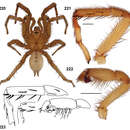Description
provided by Zookeys
Specimen preparation and condition. Specimen collected live from under debris, preserved 70% EtOH. Coloration slightly faded. Pedipalp, leg I left side removed, stored in vial with specimen. General coloration. Carapace, chelicerae, legs yellowish brown 10YR 5/6. Abdomen uniform very pale brown 10YR 7/4, dark mid dorsal band markings (Fig. 220). Cephalothorax. Carapace 4.40 long, 3.63 wide, generally glabrous with sparse thin setae, stout long black bristles on posterior fringe; pars cephalica elevated. Foveal groove deep, straight. Eyes on low mound. AER straight, PER slightly recurved. PME, AME subequal diameter. Sternum moderately setose, STRl 2.32, STRw 2.10. Posterior sternal sigilla large, positioned centrally, not contiguous, anterior sigilla pairs small, oval, marginal. Chelicerae with distinct anterior tooth row comprising 7 teeth, posterior margin with single row of small denticles. Palpal endites with patch of small cuspules on proximal, inner margin, labium with 2 cuspules, LBw 0.77, LBl 0.48. Rastellum consists of 5 stout spines not on mound. Abdomen. Setose, heavy black setae intermingled with fine black setae. Legs. Leg I: 4.45, 3.20, 2.79, 1.90, 1.55; leg IV: 4.00, 2.00. Light tarsal scopulae on legs I, II. Tarsus I with single, slightly staggered row of 8 trichobothria. Leg I spination pattern illustrated in Figures 221, 223; TSp 4, TSr 2, TSrd 4; mid-ventral metatarsus mating apophysis bearing a single blunt spine. Pedipalp. Articles stout, lacking distinct spines (Fig. 222). PTw 0.87, PTl 1.88, Bl 1.02; palpal bulb long relative to carapace length; embolus slender, with slight distal curvature (Figs 222).
Variation (10). Cl 3.94-5.00, 4.57±0.12; Cw 3.19-4.31, 3.80±0.12; STRl 2.19-2.94, 2.52±0.09; STRw 1.80-2.56, 2.18±0.08; LBw 0.62-0.80, 0.73±0.02; LBl 0.38-0.60, 0.46±0.02; leg I: 4.19-5.38, 4.75±0.13; 2.81-3.75, 3.33±0.10; 2.56-3.38, 2.97±0.09; 1.71-2.16, 1.97±0.05; 1.14-1.74, 1.51±0.06; leg IV: 3.75-4.81, 4.28±0.12; 1.88-2.31, 2.13±0.05; PTl 1.77-2.34, 2.05±0.06; PTw 0.78-0.99, 0.91±0.02; Bl 0.96-1.13, 1.04±0.02; TSp 3-7, 4.50±0.37; TSr 2-7, 4.50±0.5; TSrd 3-5, 3.50±0.22.
- bibliographic citation
- Bond J (2012) Phylogenetic treatment and taxonomic revision of the trapdoor spider genus Aptostichus Simon (Araneae, Mygalomorphae, Euctenizidae) ZooKeys 252: 1–209
- author
- Jason E. Bond
Distribution
provided by Zookeys
Aptostichus aguacaliente is distributed primarily throughout Colorado Desert habitat in the low-lying ridges surrounding the Imperial Valley (Map 27). County records comprise San Bernardino, Riverside, and Imperial. The DM (Map 28) appears to considerably overpredict the occurrence of Aptostichus aguacaliente in areas to the west in Riverside County and into eastern San Diego County but otherwise corresponds to the known distribution. Based on the DM, it was likely that the species was more widely distributed throughout the Imperial Valley and areas to its north prior to the extensive agricultural development that has occurred in the region. Males appear to wander in the late winter, early spring, January–February. Female burrows can be detected during the winter months often after soaking rains when individuals extend their burrow leaving a small mound of soil at the burrow entrance.
- bibliographic citation
- Bond J (2012) Phylogenetic treatment and taxonomic revision of the trapdoor spider genus Aptostichus Simon (Araneae, Mygalomorphae, Euctenizidae) ZooKeys 252: 1–209
- author
- Jason E. Bond

